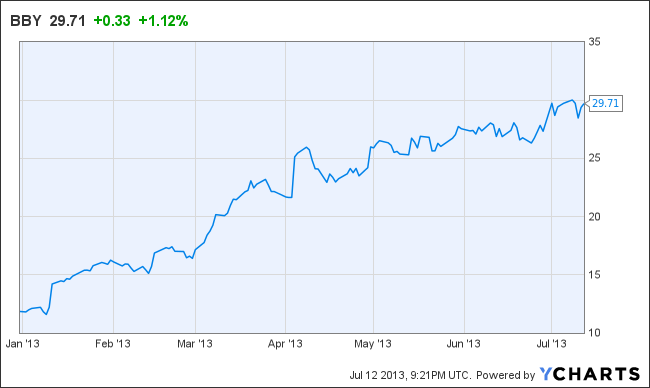Last year, electronics giant Best Buy delivered a series of disappointing earnings reports, sending investors to the exits and the company’s stock down to levels not seen in more than a decade. Many observers saw in all this the inevitable triumph of e-commerce over the big-box-store business model. Megastores like Best Buy offer a huge selection of products at low prices, but online stores offer an even bigger selection and, often, even lower prices. In effect, they outboxed the Big Boxes.
But in November, Best Buy’s newest CEO, Hubert Joly, announced his “renew blue” turnaround plan, and since the beginning of the year, Best Buy stock has been on a tear, ranking as one of the best performing S&P 500 stocks so far in 2013.
So what’s behind the headlong rise in Best Buy’s stock? Not the company’s recent performance: the firm’s most recent quarterly report showed both revenue and earnings falling year over year, as well as a decline in same-store sales, a key metric for the retail industry. It’s important to remember that a company’s stock price doesn’t reflect current profitability, but investors’ expectations about future performance. And, increasingly, analysts are buying into Joly’s vision for the company’s future. In a recent note to investors, Credit Suisse retail analyst Gary Balter raised his target price for Best Buy stock and wrote, “We believe Best Buy offers more upside in the [retail] space than any other company we cover.”
Balter maintains that Best Buy is turning its massive store base — until very recently viewed as a liability — into one of its biggest strengths. The first step is to move away from the “bigger is always better” philosophy that has long dominated the retail industry. Best Buy is closing many of its locations and moving into smaller spaces with a more focused selection of products.
(MORE: Best Buy Swears Shoppers Don’t Have to Bother Showrooming Anymore)
Joly is also leveraging his store space through partnerships with Samsung and Microsoft to create “stores within a store” across the country. Under these agreements, Samsung and Microsoft rent out space within a Best Buy to prominently feature their most popular products. The strategy should improve profitability not just through rent receipts, but also by driving sales of products elsewhere in the store.
Best Buy is also beginning to leverage its more than 1,000 locations by increasingly shipping merchandise from stores to online customers. This strategy can improve chances that an online customer will find an item in stock, and allow stores to sell returned items to online customers, two outcomes that should help the firm improve its profit margins.
Finally, Best Buy is investing in improvements to its Web business more broadly, with the hope of making its website more user-friendly and improving search functionality. Best Buy’s website receives more than a billion visitors per year, but only 1.3% of those end up purchasing a product. Balter explains that if these investments bring that conversion rate up just one percentage point, it would mean roughly $250 million more per year in operating income.
All that said, it’s worth noting that Best Buy hasn’t actually turned this promise into performance yet. And not everyone is convinced that it can complete the turnaround. Morningstar analyst R.J. Hottovy warned in May that competition in the electronics retail space is fierce, and many of the improvements Best Buy is implementing could be easily reproduced by its rivals. Furthermore, one of the main reforms Best Buy has initiated is a guarantee to match prices from competitors to help combat the practice of “showrooming,” whereby customers come to Best Buy’s stores to evaluate a product but then buy it online for less. The problem is that price matching has shrunk Best Buy’s margins as it seeks to compete with companies with much different cost structures.
In other words, Best Buy is not out of the woods yet. As Hottovy points out, any business whose success depends on matching a company like Amazon on price is going to have a tough time maintaining significant profit margins. And while the partnerships with Samsung and Microsoft are bold attempts to leverage the firm’s store base, these are untested strategies that may not pan out as Joly hopes. But at least for the time being, investors are buying into the new CEO’s turnaround plan. Now all Joly has to do is win the customers over too.
MORE: Could ‘Showrooming’ Actually Be Good for Brick-and-Mortar Retailers?


